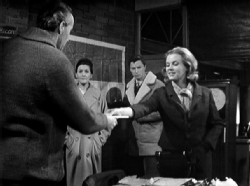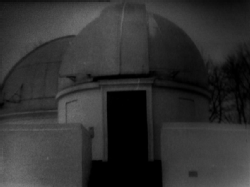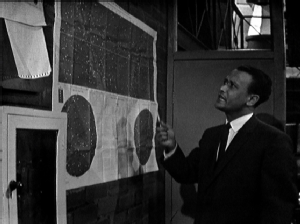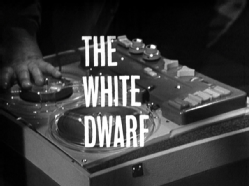The White Dwarf (The Avengers, 1963)
One of my interests in both science and science fiction is the field of Cosmic Catastrophes - the various ways in which astronomical events or phenomena might negatively impact the habitability of Earth or other human environments. There are lots of different elements of interest here, ranging from the way the astronomy is represented to what the prevalence of such events in science fiction can tell us about the psychology of humans themselves, and it makes for a fun seminar which I teach annually in our interdisciplinary “Habitability in the Universe” graduate module.
I recently came across an interesting example of this genre. The Avengers was a 1960s crime and espionage drama on UK television which frequently strayed into science fiction themes and which I’ve written about before. In 1963, an episode appeared called “The White Dwarf”, written by Malcolm Hulke (also known for his work on Doctor Who) and directed by Richmond Harding. In this story, a looming cosmic catastrophe seems to be the cause of a dramatic murder... and perhaps more than one.
First a brief plot summary (note: minor spoilers):
At Tor Point observatory, in Cornwall, a Professor Richter has identified a white dwarf star which he believes to be the binary partner of our Sun, returning to the Solar System at the end of a very long orbit. The consequences will be inevitable disaster: a collision with the Sun and the destruction of Earth. The British Government are keeping this secret, pending confirmation, but have mobilised troops in anticipation of public disorder when the news breaks. Richter is murdered while making a crucial observation, and we learn that Baker, an official at the Ministry of Science (Astronomy Division), has shared the news with his financier brother. Together with an American colleague, the financier is planning to make a profit through insider trading on the information. While waiting for an alternate observation opportunity, Professor Rahim suggests measuring a cometary orbit to look for effects of the White Dwarf. He too is murdered before the observations can be taken.
 Secret agent and anthropologist Cathy Gale is sent undercover to the observatory, ostensibly to observe Mars in opposition. She meets the observatory director, Professor Cartwright, and two other astronomers, Dr Elizabeth Fuller and Dr Luke Richter (son of the murdered man). Through various shenanigans, the villains are tricked into believing that the end of the world has been confirmed and one of them breaks, admitting the murders and attempted fraud. Inevitably, the truth is that the world is safe.
Secret agent and anthropologist Cathy Gale is sent undercover to the observatory, ostensibly to observe Mars in opposition. She meets the observatory director, Professor Cartwright, and two other astronomers, Dr Elizabeth Fuller and Dr Luke Richter (son of the murdered man). Through various shenanigans, the villains are tricked into believing that the end of the world has been confirmed and one of them breaks, admitting the murders and attempted fraud. Inevitably, the truth is that the world is safe.
There are some interesting features here. Let’s look at the astronomy first.
Close to the start of the episode, Cathy Gale - technically an anthropologist - gives her colleague Steed (and through him the audience) an impromptu miniature lecture:
“Stars are really like our Sun: burning masses of heated gas. Every now and then one of them explodes.”
“Every now and then, meaning every few million years!”
“Well, not necessarily. There was one quite recently, in 1054 - the Crab nebula is the debris from it. You see when it explodes - as our Sun will one day - there’s an enormous outgoing of energy. During the next few days the heat and light of the exploding star increases from 1 to 100 million times its original state.”
“And when it’s all over, you get a white dwarf.”
“Yes, probably not much bigger than our own Earth. After that it becomes a space wanderer. There’s a theory you know that our own Solar System started this way. First there were twin binary stars. Then one of them exploded and some of the debris became the planets.”
How much of this is true? Well, it’s true that stars at the end of their lives throw off a large amount of material, that a white dwarf is a compact stellar remnant, and that the Solar nebula was enriched by supernovae in the past. It’s also true that the majority of stars in the Milky Way reside in binaries or multiple systems. On the other hand, we now know that supernovae (the explosive end of massive stars, leaving neutron star or black hole remnants) and novae (thermonuclear explosions on the surface of low mass white dwarf stars) are different phenomena, and that our Sun is too small ever to go supernova. It will produce a white dwarf in the distant future, but through ejection of its outer envelope during the red giant phase. This was already well understood by the 1960s, although given the similarity in names between novae and supernovae, it’s perhaps understandable that the details become blurred in popular culture.
We also now know with a fairly high degree of certainty that the Sun does not (and never has had) a companion. In the 1960s, this was a perfectly plausible scenario which had, in fact, been discussed in publications dating back to the 1930s. At the time, observing faint objects across large sky areas was extremely difficult and much of the sky was not regularly monitored. As civil servant Baker put it: “The chances of any astronomer even looking at the dwarf, let alone observing its path, are on a par with your looking through a pinhole and seeing one particular seagull nesting on the White Cliffs of Dover”. However the advent of the current all-sky surveys (many of them robotic and processed using automatic algorithms) now reveals hundreds of supernovae per year, and suggests that we couldn’t have missed any star, even a white dwarf, close enough to interact this way (let alone on a timescale of months). Similarly, we now know that the dynamics of the Sun are consistent with no companion - a result of decades of work and vast automated surveys.
 If the script shows a real interest in astrophysics, then the filming, casting and direction demonstrates the same. The observatory exterior scenes appear to have been filmed at the University of London observatory at Mill Hill. The location of the interior scenes is harder to confirm without a close inspection of the site [1], but the traditional thick-walled construction and robustness of the observatory lends the scenes a verisimilitude they might otherwise have lacked. While this site is now a teaching facility belonging to UCL and constantly struggling with light pollution, in the 1960s it was still large enough and remote enough to be an important research facility. The episode also shows scenes in which glass observing plates are inserted into a telescope (likely the Radcliffe twin refractor, the design of which can be seen here) where they are superposed over the focal plane. By aligning the background star field, the proper motion of nearby sources (such as the eponymous white dwarf) can be assessed by an observer looking through the eye-piece. This seems unlikely to ever have been a genuine method - in reality moving stars were generally identified by superposing image frames using optical equipment on a work bench. Both in method and in detail the science is not exactly perfect: the idea that the same source is only observable from an observatory at near-random, widely separated intervals, or that a source can be behind the Moon from one location on Earth but not another, is rather a strange one, for example.
If the script shows a real interest in astrophysics, then the filming, casting and direction demonstrates the same. The observatory exterior scenes appear to have been filmed at the University of London observatory at Mill Hill. The location of the interior scenes is harder to confirm without a close inspection of the site [1], but the traditional thick-walled construction and robustness of the observatory lends the scenes a verisimilitude they might otherwise have lacked. While this site is now a teaching facility belonging to UCL and constantly struggling with light pollution, in the 1960s it was still large enough and remote enough to be an important research facility. The episode also shows scenes in which glass observing plates are inserted into a telescope (likely the Radcliffe twin refractor, the design of which can be seen here) where they are superposed over the focal plane. By aligning the background star field, the proper motion of nearby sources (such as the eponymous white dwarf) can be assessed by an observer looking through the eye-piece. This seems unlikely to ever have been a genuine method - in reality moving stars were generally identified by superposing image frames using optical equipment on a work bench. Both in method and in detail the science is not exactly perfect: the idea that the same source is only observable from an observatory at near-random, widely separated intervals, or that a source can be behind the Moon from one location on Earth but not another, is rather a strange one, for example.
 The personnel of the observatory are perhaps more surprising still, and reflect a touching confidence in the openness and equity of scientific establishments. Unlike many science fictions, this episode is set in the contemporary early 1960s. Nonetheless, the observatory staff includes two female astronomers (admittedly this includes the undercover “Dr.” Gale and an astronomer who is also the love interest) and Indian Professor Rahim of the University of Bombay. These characters are accepted without comment or any particular note by the others, but would have surprised most audiences of the time.
The personnel of the observatory are perhaps more surprising still, and reflect a touching confidence in the openness and equity of scientific establishments. Unlike many science fictions, this episode is set in the contemporary early 1960s. Nonetheless, the observatory staff includes two female astronomers (admittedly this includes the undercover “Dr.” Gale and an astronomer who is also the love interest) and Indian Professor Rahim of the University of Bombay. These characters are accepted without comment or any particular note by the others, but would have surprised most audiences of the time.
In reality, the scarcity of women and people of colour in astronomy is still significant in 2021: a rather sad indictment of the field.
Moving aside from the world of astrophysics, it’s worth looking a little at the reactions to the putative discovery of the white dwarf.
-
The government’s first reaction is secrecy and army mobilisation, anticipation of public unrest and a top secret effort to check the data before notifying other governments.
-
The reaction of a civil servant official is to confide in his brother “in a moment of distress” while preventing others from doing the same.
-
The reaction of a financier and his partners is one of disbelief - and a desire to seek to profit from the coming panic, even if that means generating it.
-
The reaction of almost everyone else in the know, including Steed and Gale, is a kind of tense apathy - they continue with their work as if all is normal, while alternating between denial and wondering how best to spend their final months, hinting at a fey, fin-de-siecle recklessness.
Fiction in which reactions to the end of the world are explored is fairly common. Examples include La Fin du Mond (Flammarian 1894), Umbrella in the Sky (Tubb 1961), The Black Cloud (Hoyle 1957), Seveneves (Stephenson 2015), Deep Impact (dir. Leder 1998), When Worlds Collide (Wylie & Balmer 1933) and Project S.W.O.R.D. (Anderson 1967). In almost all of these, there is a balance between efforts to secure salvation (if only for a select few) and chaos as social mores, and the fear of consequences that underlies law and order, break down. What’s interesting about “The White Dwarf” is that it takes place entirely within that “will it/won’t it?” window where destruction appears likely, but far from certain, and the secret is holding. In fact, so firmly embedded is it in that tense atmosphere that it remains surprisingly ambiguous at the end of the episode whether or not the white dwarf’s approach is real, with the answer implicit rather than explicit.
The tension works well in the context of the edgy espionage- and crime-oriented early Avengers stories, and allows Steed and Cathy Gale to display their imperturbable coolness in the face of matters outside their control. It also illustrates very clearly how unprepared most human beings (either collectively or individually) are to contemplate existential threats or set aside their own personal interests whatever the threat.
So, together with so many other works, “The White Dwarf” lets us explore what is important in life and how we do or don’t value the world in which we live. More so than any other threat, cosmic catastrophe presents a true danger of not just disaster but total human extinction. Fortunately, to the best of our knowledge and regardless of endless internet conspiracy theories, Earth is not under any particular threat. It is no longer possible for the thousands of astronomers scattered around the world and across social media to keep a catastrophic discovery secret (if it ever was, which I honestly doubt). Despite, or perhaps in part because of that, it’s always fun to play with the great cosmic what-if.
"The White Dwarf", Elizabeth Stanway, Cosmic Stories blog, 13th June 2021
[1] My thanks to Dr Stephen Fossey and Prof Giorgio Savini for responding to my random query about Mill Hill Observatory - this still-active facility has appeared in a number of popular media series, and has a fascinating history in monitoring locations and movements of astronomical objects. Further research will be needed to confirm whether the interior scenes of "The White Dwarf" were also filmed at the observatory - if anyone has any information in this regard, do please get in touch!

